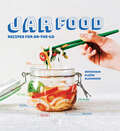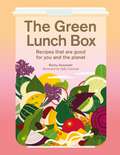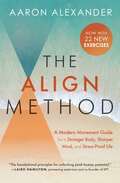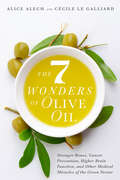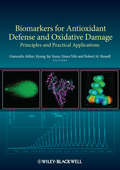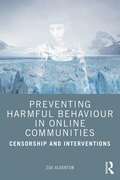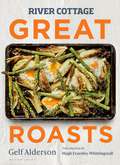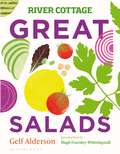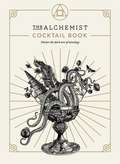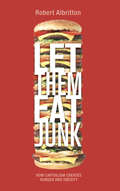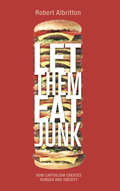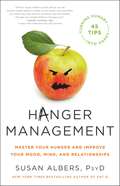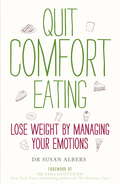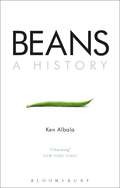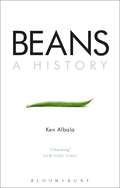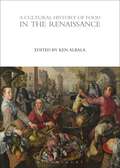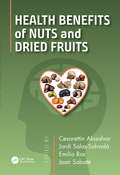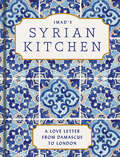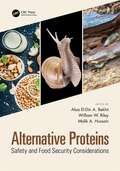- Table View
- List View
Ed says U said: Eating Disorder Translator
by June Alexander Catherine SangsterA unique resource of information on eating disorders (EDs), this book aims to improve communication between people with EDs and their loved ones by revealing the ED mind set and decoding language choices. Full of everyday examples, it details the common pitfalls and gives invaluable advice on how best to defuse the triggers.
Jar Food: Recipes For On-the-go
by Dominique Elöise AlexanderTake wholesome food with you every day whatever you are doing. Whether it is having breakfast on the go or taking ten minutes for a breath of fresh air and a quick snack in the afternoon, Jar Food is full of simple, delicious recipes that you can make with minimal effort.
The Green Lunch Box: Recipes that are good for you and the planet
by Becky AlexanderThe Green Lunch Box is packed with delicious, healthy, plant-based lunches to help you save the planet in your lunch break.Making your own lunch just a few times a week saves money, packaging and precious time. Discover simple, short recipes for hot boxes, soups, salads, wraps and snacks that make the most of your everyday fresh and store cupboard ingredients. Learn to love your leftovers, master the art of batch cooking and discover ingenious sustainable ways to pack (and eat) your lunch.Features sixty beautifully illustrated recipes, including: Smashed beets and rainbow salad with hazelnut dukkha,Burrito box with charred sweetcorn, avocado, habanero peppers and lime salsa,Black lentil, almond and coconut dahl with crispy cumin cauliflower,Courgette, carrot, apple and lime slaw with toasted pumpkin seeds,Spicy parsnip soup with crispy harissa chickpeas,Peanut butter, lime, chilli and rocket bagel,Mushroom, white bean, miso and leek parcels
The Align Method: 5 Movement Principles for a Stronger Body, Sharper Mind, and Stress-Proof Life
by Aaron AlexanderCelebrity manual therapist and movement coach Aaron Alexander shows readers how posture and body alignment are powerful tools for building strength, achieving peak performance, reducing pain, and approaching the world with a new sense of confidence. Good posture is about more than standing up straight: It can change your mood, alleviate pain, rid your body of stressful tension, and may be the difference between getting that raise you've wanted and attracting your ideal mate, or not. But in order to reap all those benefits, the body must be properly integrated. Celebrity movement coach and manual therapist Aaron Alexander offers a revolutionary approach to body alignment to build strength, reduce pain, and put you on a direct path to peak performance that is both fun and accessible. The Align Method centers on five daily optimizations that can be easily integrated into any workout, mindfulness practice, or daily life activity: Floor SittingHangingHip-HingingWalkingNose Breathing A truly aligned life isn't limited to sweating in a gym or stretching in a yoga studio, and Alexander provides the fundamental principles to optimize your physical and mental process in any situation. Blending Eastern philosophy with Western mechanics, The Align Method brilliantly outlines the necessary tools to leverage the power of your own senses and body language to feel more flexible and confident, and details exactly how to reshape your environment for enhanced creativity and longevity. This is the quintessential user's manual to feeling better than you ever thought possible, and looking great while you're at it!
The 7 Wonders of Olive Oil: Stronger Bones, Cancer Prevention, Higher Brain Function, and Other Medical Miracles of the Green Nectar
by Alice Alech Cécile Le GalliardTwo olive oil enthusiasts explain the role of olive oil in the Mediterranean diet, olive oil’s exceptional nutritional value, and provide tips on cooking, buying, and storing the green nectar.
Biomarkers for Antioxidant Defense and Oxidative Damage: Principles and Practical Applications
by Giancarlo Aldini Kyung-Jin Yeum Etsuo Niki Robert M. RussellBiomarkers for Antioxidant Defense and Oxidative Damage: Principles and Practical Applications critically evaluates the basic concepts and methodologies of conventional biomarkers as well as current state-of-the-art assays for measuring antioxidant activity/oxidative stress and their practical applications. . Biomarkers for Antioxidant Defense and Oxidative Damage: Principles and Practical Applications will be of a great interest to scientists who are involved in basic research on oxidation, applied scientists evaluating the effects of nutraceuticals or pharmaceutical compounds on antioxidant activity/oxidative stress, and physicians who want to understand the degree of oxidative damage in patients with certain chronic diseases. Discovering sensitive and specific biomarkers for systemic oxidative damage is essential to understand the role of oxidative stress in human disease. Once these roles are clearly understood, we are able to identify novel drug and nutraceutical targets. This volume goes beyond conventional analytical methods of measuring overall antioxidant activity and provides insight to the discovery of biomarkers that reveal information on specific areas of oxidative stress. Contributed by an international list of experts, Biomarkers for Antioxidant Defense and Oxidative Damage: Principles and Practical Applications describes both conventional biomarkers and recent developments in this area. Special Features: Discusses conventional biomarkers as well as recent advances for measuring antioxidants and oxidative stress Biomarkers for lipid peroxidation: isoprostane, hydroxyloctadecaenoic acid, oxysterols, and reactive carbonyl species from lipid peroxidation Biomarkers for protein oxidation: carbonylation, tyrosine oxidation, ubiquitin-conjugation Biomarkers for DNA oxidative damage: comet assay, hydroxylated nucleotides, and exocylcic DNA adducts Recently developed biomarkers from cutting-edge technology
Preventing Harmful Behaviour in Online Communities: Censorship and Interventions
by Zoe AldertonPreventing Harmful Behaviour in Online Communities explores the ethics and logistics of censoring problematic communications online that might encourage a person to engage in harmful behaviour. Using an approach based on theories of digital rhetoric and close primary source analysis, Zoe Alderton draws on group dynamics research in relation to the way in which some online communities foster negative and destructive ideas, encouraging community members to engage in practices including self-harm, disordered eating, and suicide. This book offers insight into the dangerous gap between the clinical community and caregivers versus the pro-anorexia and pro-self-harm communities – allowing caregivers or medical professionals to understand hidden online communities young people in their care may be part of. It delves into the often-unanticipated needs of those who band together to resist the healthcare community, suggesting practical ways to address their concerns and encourage healing. Chapters investigate the alarming ease with which ideas of self-harm can infect people through personal contact, community unease, or even fiction and song and the potential of the internet to transmit self-harmful ideas across countries and even periods of time. The book also outlines the real nature of harm-based communities online, examining both their appeal and dangers, while also examining self-censorship and intervention methods for dealing with harmful content online. Rather than pointing to punishment or censorship as best practice, the book offers constructive guidelines that outline a more holistic approach based on the validity of expressing negative mood and the creation of safe peer support networks, making it ideal reading for professionals protecting vulnerable people, as well as students and academics in psychology, mental health, and social care.
Preventing Harmful Behaviour in Online Communities: Censorship and Interventions
by Zoe AldertonPreventing Harmful Behaviour in Online Communities explores the ethics and logistics of censoring problematic communications online that might encourage a person to engage in harmful behaviour. Using an approach based on theories of digital rhetoric and close primary source analysis, Zoe Alderton draws on group dynamics research in relation to the way in which some online communities foster negative and destructive ideas, encouraging community members to engage in practices including self-harm, disordered eating, and suicide. This book offers insight into the dangerous gap between the clinical community and caregivers versus the pro-anorexia and pro-self-harm communities – allowing caregivers or medical professionals to understand hidden online communities young people in their care may be part of. It delves into the often-unanticipated needs of those who band together to resist the healthcare community, suggesting practical ways to address their concerns and encourage healing. Chapters investigate the alarming ease with which ideas of self-harm can infect people through personal contact, community unease, or even fiction and song and the potential of the internet to transmit self-harmful ideas across countries and even periods of time. The book also outlines the real nature of harm-based communities online, examining both their appeal and dangers, while also examining self-censorship and intervention methods for dealing with harmful content online. Rather than pointing to punishment or censorship as best practice, the book offers constructive guidelines that outline a more holistic approach based on the validity of expressing negative mood and the creation of safe peer support networks, making it ideal reading for professionals protecting vulnerable people, as well as students and academics in psychology, mental health, and social care.
River Cottage Great Roasts
by Gelf AldersonLet the oven do the work with these quick and simple ingredient-focussed recipes from the River Cottage kitchenIn River Cottage Great Roasts, all you will need are good ingredients, an oven and some simple bakeware to create easy weeknight dinners, showstopping Sunday roasts, fuss-free breakfasts, tea-time treats and indulgent puds. Often only requiring one roasting tin and minimal prep, these are recipes that let the oven do the hard work, and leave you with very little washing up:Spiced whole cauliflower with preserved lemon and yoghurtRoast mushrooms with beer and dumplingsPot roast brisket with orange and star aniseRipped potato oven chips with smoked chilli and roast garlic dipCreamy fish pieRoasted cherry and almond crumblePears with ginger and toffeeDivided into chapters like Breakfast & Brunch, One-tray Wonders, Sunday Roast, Super Sides and Puddings, the recipes all harness the power of the oven to transform everyday ingredients into their more deliciously caramelised, roasted counterparts.
River Cottage Great Roasts
by Gelf AldersonLet the oven do the work with these quick and simple ingredient-focussed recipes from the River Cottage kitchenIn River Cottage Great Roasts, all you will need are good ingredients, an oven and some simple bakeware to create easy weeknight dinners, showstopping Sunday roasts, fuss-free breakfasts, tea-time treats and indulgent puds. Often only requiring one roasting tin and minimal prep, these are recipes that let the oven do the hard work, and leave you with very little washing up:Spiced whole cauliflower with preserved lemon and yoghurtRoast mushrooms with beer and dumplingsPot roast brisket with orange and star aniseRipped potato oven chips with smoked chilli and roast garlic dipCreamy fish pieRoasted cherry and almond crumblePears with ginger and toffeeDivided into chapters like Breakfast & Brunch, One-tray Wonders, Sunday Roast, Super Sides and Puddings, the recipes all harness the power of the oven to transform everyday ingredients into their more deliciously caramelised, roasted counterparts.
River Cottage Great Salads
by Gelf AldersonGelf Alderson has spent years serving up original, veg-centric meals to delight the guests at River Cottage. His recipes redefine the idea of salad, as playful flavour pairings, clever techniques and vibrant dressings bring out the very best in seasonal produce. Divided into chapters such as Quick, Hearty, Spicy and Lunchbox, these recipes use everyday ingredients, and give plenty of suggestions for seasonal swaps and delicious alternatives. With minimal effort, you'll be serving up showstoppers such as Char-grilled cabbage, pickled pears, pesto and walnuts, Honey-glazed leftover belly perk with shredded summer veg and Roast asparagus, feta, almonds and sourdough croutons. There's also a whole chapter of dressings and pickles to enliven even a simple bowl of leaves. With more than 80 recipes and countless more variations to be explored, Gelf demonstrates how, with a bit of creativity and flair, simple ingredients can be combined to make truly great salads.
River Cottage Great Salads
by Gelf AldersonRiver Cottage head chef Gelf Alderson shows us how to create truly knockout salads using simple, seasonal ingredientsGelf Alderson has spent years serving up original, veg-centric meals to delight the guests at River Cottage. His recipes redefine the idea of salad, as playful flavour pairings, clever techniques and vibrant dressings bring out the very best in seasonal produce. With all the delicious summer fruit and veg coming into season right now, you'll be spoilt for choice with these tantalising recipes. Why not try:· Curried roots, pearled barley and parsley· Merguez roast squash, pears and chicory· Apple with toasted hazelnuts and lime· Leftover lamb, harissa and char-grilled peppers· Lentils with green herbs and lemonDivided into easy chapters like Quick, Hearty, Spicy and Lunchbox, these recipes use everyday ingredients, and give plenty of suggestions for seasonal swaps and delicious alternatives. With more than 80 recipes and countless more variations to be explored, Gelf demonstrates how, with a bit of creativity and flair, simple ingredients can be combined to make truly great salads.
The Alchemist Cocktail Book: Master the dark arts of mixology
by The Alchemist100 spell-binding, crowd-pleasing cocktails.Work some magic at home with these original cocktail recipes from everyone's favourite experimental bar, The Alchemist. Elevate your mixology skills and bring some creativity to your bar cart with unique and show-stopping tipple time recipes, from their iconic Caramelised Rum Punch and Smokey Old Fashioned, to new takes on the cocktail classics. With chapters from Chemistry & Theatre, Twisted Classics and New Wave to Classics and Low & No Alcohol, The Alchemist Cocktail Book truly has something for everyone, from mixing novices to experienced bartenders. Bring some dramatic flair to your cocktail hour, with recipes including:Lavender DaiquiriPalomaRhubarb and Custard SourBananagroniMaple ManhattanCola Bottle LibreGrapefruit and Apricot Martini
Let Them Eat Junk: How Capitalism Creates Hunger and Obesity
by Robert AlbrittonThis book to analyses the food industry from a Marxist perspective.*BR**BR*Let The Eat Junk argues that the capitalist system, far from delivering on the promise of cheap, nutritious food for all, has created a world where 25% of the world population are over-fed and 25% are hungry. This malnourishment of 50% of the world's population is explained systematically, a refreshing change from accounts that focus on cultural factors and individual greed. Robert Albritton details the economic relations and connections that have put us in a situation of simultaneous oversupply and undersupply of food.*BR**BR*This explosive book provides yet more evidence that the human cost of capitalism is much bigger than those in power will admit.
Let Them Eat Junk: How Capitalism Creates Hunger and Obesity
by Robert AlbrittonThis book to analyses the food industry from a Marxist perspective.*BR**BR*Let The Eat Junk argues that the capitalist system, far from delivering on the promise of cheap, nutritious food for all, has created a world where 25% of the world population are over-fed and 25% are hungry. This malnourishment of 50% of the world's population is explained systematically, a refreshing change from accounts that focus on cultural factors and individual greed. Robert Albritton details the economic relations and connections that have put us in a situation of simultaneous oversupply and undersupply of food.*BR**BR*This explosive book provides yet more evidence that the human cost of capitalism is much bigger than those in power will admit.
Hanger Management: Master Your Hunger and Improve Your Mood, Mind, and Relationships
by Susan AlbersThe complete program for mastering your "hanger," from mindful-eating pioneer Dr. Susan Albers -- with 45 tips to turn hanger into happiness. It happens to all of us. One minute you're happily going about your day, and a few seconds later you're a snappy, illogical version of yourself. The culprit? Hanger. We're living busier lives than ever before, and when we forget to eat -- or accidentally overeat -- hunger can make us angry, unreasonable, and dull, with big impacts on our emotional and psychological well being. And hanger can become a cycle. When we get too hungry, we're more likely to make food decisions we regret, which sets us up for another hanger crash later on. The good news: when we make better decisions about food, we think more clearly, connect better in our relationships, and improve our performance. Hanger Management is the book that can help you break this cycle and create healthy habits that fuel and empower you.In Hanger Management, New York Times bestselling author and clinical psychologist Susan Albers sheds light on the causes of hanger, and shares 45 of her best tips for managing it well. By learning to stay on top of your hunger cues, cultivating a better understanding of your appetite, and creating a better overall relationship with food, you'll become happier -- and healthier -- for life.
Hanger Management: Master Your Hunger and Improve Your Mood, Mind, and Relationships
by Susan AlbersThe complete program for mastering your "hanger," from mindful-eating pioneer Dr. Susan Albers -- with 45 tips to turn hanger into happiness. It happens to all of us. One minute you're happily going about your day, and a few seconds later you're a snappy, illogical version of yourself. The culprit? Hanger. We're living busier lives than ever before, and when we forget to eat -- or accidentally overeat -- hunger can make us angry, unreasonable, and dull, with big impacts on our emotional and psychological well being. And hanger can become a cycle. When we get too hungry, we're more likely to make food decisions we regret, which sets us up for another hanger crash later on. The good news: when we make better decisions about food, we think more clearly, connect better in our relationships, and improve our performance. Hanger Management is the book that can help you break this cycle and create healthy habits that fuel and empower you.In Hanger Management, New York Times bestselling author and clinical psychologist Susan Albers sheds light on the causes of hanger, and shares 45 of her best tips for managing it well. By learning to stay on top of your hunger cues, cultivating a better understanding of your appetite, and creating a better overall relationship with food, you'll become happier -- and healthier -- for life.
Quit Comfort Eating: Lose weight by managing your emotions
by Dr Susan Albers PsyDWhy can't so many smart people lose weight? The answer: low emotional intelligence can lock you into a vicious cycle of dieting failure. Dr Susan Albers, accomplished expert in emotional eating and weight loss, has created an accessible three-step plan that will teach you how to combat the most common emotional barriers to weight loss. Her EAT plan tackles comfort eating, the pressure of social eating so common in offices, stress-triggered eating, eating to avoid emotional problems and using food to numb trauma.Drawing on mindfulness, Dr Albers provides 25 tools and techniques readers can use to tailor their eating to the demands of their own lives, their preferences and moods. Reverse a lifetime of overeating and comfort bingeing with Quit Comfort Eating.
Beans: A History
by Ken AlbalaThis is the story of the bean, the staple food cultivated by humans for over 10,000 years. From the lentil to the soybean, every civilization on the planet has cultivated its own species of bean. The humble bean has always attracted attention - from Pythagoras' notion that the bean hosted a human soul to St. Jerome's indictment against bean-eating in convents (because they "tickle the genitals"), to current research into the deadly toxins contained in the most commonly eaten beans. Over time, the bean has been both scorned as "poor man's meat" and praised as health-giving, even patriotic. Attitudes to this most basic of foodstuffs have always revealed a great deal about a society. Featuring a new preface from author Ken Albala, Beans: A History takes the reader on a fascinating journey across cuisines and cultures.
Beans: A History
by Ken AlbalaThis is the story of the bean, the staple food cultivated by humans for over 10,000 years. From the lentil to the soybean, every civilization on the planet has cultivated its own species of bean. The humble bean has always attracted attention - from Pythagoras' notion that the bean hosted a human soul to St. Jerome's indictment against bean-eating in convents (because they "tickle the genitals"), to current research into the deadly toxins contained in the most commonly eaten beans. Over time, the bean has been both scorned as "poor man's meat" and praised as health-giving, even patriotic. Attitudes to this most basic of foodstuffs have always revealed a great deal about a society. Featuring a new preface from author Ken Albala, Beans: A History takes the reader on a fascinating journey across cuisines and cultures.
A Cultural History of Food in the Renaissance (The Cultural Histories Series)
by Ken AlbalaFood and attitudes toward it were transformed in Renaissance Europe. The period between 1300 and 1600 saw the discovery of the New World and the cultivation of new foodstuffs, as well as the efflorescence of culinary literature in European courts and eventually in the popular press, and most importantly the transformation of the economy on a global scale. Food became the object of rigorous investigation among physicians, theologians, agronomists and even poets and artists. Concern with eating was, in fact, central to the cultural dynamism we now recognize as the Renaissance.A Cultural History of Food in the Renaissance presents an overview of the period with essays on food production, food systems, food security, safety and crises, food and politics, eating out, professional cooking, kitchens and service work, family and domesticity, body and soul, representations of food, and developments in food production and consumption globally.
Health Benefits of Nuts and Dried Fruits
by Cesarettin Alasalvar Jordi Salas-Salvadó Emilio Ros Joan SabatéNuts and dried fruits are part of our daily diet. They are consumed whole or as ingredients of many food products such as muffins, cereals, chocolates, energy bars, breads, and cookies, among others. Health Benefits of Nuts and Dried Fruits provides a comprehensive overview of the literature on the health benefits of nuts and dried fruits. The book summarizes the current state of knowledge in key research areas and provides ideas for future scientific research and product development. Nuts, a term that comprises tree nuts and peanuts, are highly nutritious, containing health-promoting macronutrients, micronutrients, vitamins, and bioactive phytochemicals; they are one of the edible foods with the highest content in antioxidants. The consumption of nuts is recognized for its health-promoting properties, which ranges from a consistent cholesterol-lowering effect in clinical trials to a robust association with reduced risk of cardiovascular disease and all-cause mortality in prospective studies. In spite of the high energy content of nuts, there is no evidence that their frequent consumption promotes obesity, and they may even help control it. Dried fruits, which serve as important healthful snacks worldwide, are nutritionally equivalent to fresh fruits while providing all of their bioactive components in concentrated form. While the evidence level concerning the health effects of dried fruits lags behind that on nuts, it suggests that individuals who consume dried fruits regularly have a lower risk of cardiovascular disease, obesity, and other non-communicable diseases. Main features of the book concerning nuts and dried fruits: • Provides detailed information on health effects • Highlights current regulation and health claims • Provides updated dietary recommendations • Describes nutrient absorption and metabolism • Discusses mechanisms implicated in the health effects Although this book is intended primarily as a reference, by comprehensively reviewing the current state of knowledge it can guide future research on the topic. Among others, food scientists, biochemists, nutritionists, health professionals, decision makers, and regulatory agencies can draw much benefit from its contents. Hopefully, it will help in public health strategies to promote healthy aging and improve population wellbeing.
Health Benefits of Nuts and Dried Fruits
by Cesarettin Alasalvar Jordi Salas-Salvado Emilio Ros Joan SabateNuts and dried fruits are part of our daily diet. They are consumed whole or as ingredients of many food products such as muffins, cereals, chocolates, energy bars, breads, and cookies, among others. Health Benefits of Nuts and Dried Fruits provides a comprehensive overview of the literature on the health benefits of nuts and dried fruits. The book summarizes the current state of knowledge in key research areas and provides ideas for future scientific research and product development. Nuts, a term that comprises tree nuts and peanuts, are highly nutritious, containing health-promoting macronutrients, micronutrients, vitamins, and bioactive phytochemicals; they are one of the edible foods with the highest content in antioxidants. The consumption of nuts is recognized for its health-promoting properties, which ranges from a consistent cholesterol-lowering effect in clinical trials to a robust association with reduced risk of cardiovascular disease and all-cause mortality in prospective studies. In spite of the high energy content of nuts, there is no evidence that their frequent consumption promotes obesity, and they may even help control it. Dried fruits, which serve as important healthful snacks worldwide, are nutritionally equivalent to fresh fruits while providing all of their bioactive components in concentrated form. While the evidence level concerning the health effects of dried fruits lags behind that on nuts, it suggests that individuals who consume dried fruits regularly have a lower risk of cardiovascular disease, obesity, and other non-communicable diseases. Main features of the book concerning nuts and dried fruits: • Provides detailed information on health effects • Highlights current regulation and health claims • Provides updated dietary recommendations • Describes nutrient absorption and metabolism • Discusses mechanisms implicated in the health effects Although this book is intended primarily as a reference, by comprehensively reviewing the current state of knowledge it can guide future research on the topic. Among others, food scientists, biochemists, nutritionists, health professionals, decision makers, and regulatory agencies can draw much benefit from its contents. Hopefully, it will help in public health strategies to promote healthy aging and improve population wellbeing.
Imad’s Syrian Kitchen
by Imad AlarnabA bustling, vibrant tour of flavour-packed Syrian dishes 90 sensational recipes celebrating the flavours of Syria, that can easily be made in the comfort of your own home
Alternative Proteins: Safety and Food Security Considerations
by Alaa El-Din A. BekhitIn the last decade, there has been substantial research dedicated towards prospecting physiochemical, nutritional and health properties of novel protein sources. In addition to being driven by predictions of increased population and lack of a parallel increase in traditional protein sources, main drivers for the rise in novel proteins/ novel foods research activities is linked to significant changes in young consumers’ attitudes toward red meat consumption and their interest in new alternative protein products. Alternative Proteins: Safety and Food Security Considerations presents up-to-date information on alternative proteins from non-meat sources and examines their nutritional and functional roles as food sources and ingredients. Emphasis is placed on the safety of these novel proteins and an evaluation of their potential contribution to food security. Motivations for novel proteins and restrictions for their use are also discussed. Key Features: Explains potential improvements to alternative proteins through the employment of novel processing techniques. Contains the first review on keratin as an alternative protein source. Explores first comprehensive evaluation of the religious aspects of novel proteins. Describes methods for the detection and evaluation of health hazards. Discusses guidelines, regulatory issues and recommendations for food safety Additionally, this book covers fundamental and recent developments in the production of alternative proteins, and examines safety and consumer acceptability wherever information is available. The sources and processing options for alternative proteins and their impact on final product characteristics are also covered. A collective contribution from international researchers who are active in their field of research and have made significant contributions to the the food sciences, this book is beneficial to any researcher interested in the the food science and safety of alternative proteins.

